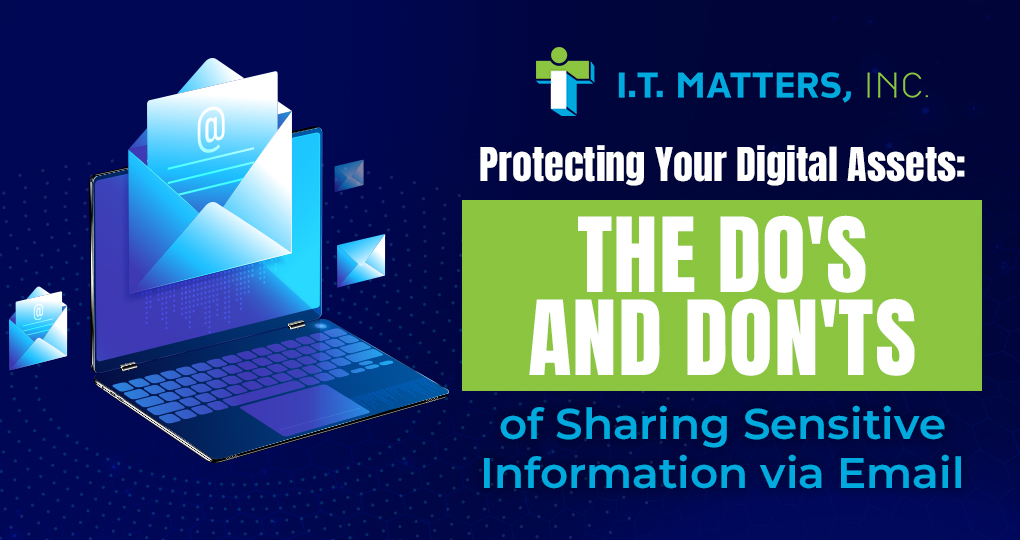In today’s digital age, email has become an integral part of our personal and professional lives. While it offers convenience and speed, it’s important to be mindful of the sensitive information we share through this medium.
You can’t assume that it’s an entirely secure method of communication. Email addresses can be spoofed, messages can be intercepted or forwarded—the list of potential risks is long. Make sure you understand what should be shared via email, and what shouldn’t by reviewing this list of Do’s and Don’ts.
Email Security Don’ts…
Don’t Divulge Personal Information
Avoid including sensitive personal information such as your social security number, credit card details, or security-associated information (your birth date or mother’s maiden name) in your emails. This information can be easily intercepted by hackers and used for fraudulent activities.
Don’t Compromise Confidential Information
Do not share confidential information such as trade secrets, financial data, or legal documents via email. This information can be easily leaked or hacked, leading to serious consequences.
Don’t Share Passwords
Do not include your passwords in your emails. This information can be easily intercepted by hackers and used to gain unauthorized access to your accounts. Instead, use a secure password manager to store your passwords.
Email Security Do’s…
Use Encryption
When exchanging sensitive information via email, employ encryption methods to protect the content from unauthorized access. Encryption converts the information into an unreadable format, ensuring that only the intended recipient can decipher it. Implementing email encryption tools or secure file-sharing platforms is recommended for secure communication.
Educate Employees
If you run a business, it’s essential to educate your employees about the risks associated with sharing sensitive information via email. Conduct regular cybersecurity awareness training sessions to reinforce best practices and promote a security-conscious culture within your organization.
Implement Two-Factor Authentication (2FA)
Enable two-factor authentication for your email accounts and encourage your clients to do the same. 2FA adds an extra layer of security by requiring a second verification method, such as a unique code sent to your smartphone, in addition to your password. This prevents unauthorized access even if your password gets compromised.
Verify the Recipient
Before sending any sensitive information via email, double-check the recipient’s email address to ensure it’s accurate and belongs to the intended recipient. Mistakenly sending sensitive data to the wrong person can lead to unintended consequences and potential data breaches.
Report Suspicious Emails
If you receive an email requesting sensitive information or suspect it to be a phishing attempt, report it to your IT department or email service provider immediately. Educate your clients on how to identify phishing emails, including looking for suspicious email addresses, poor grammar, or requests for urgent actions.
Avoid Malicious Attachments
Do not open attachments from unknown sources or suspicious emails. These attachments may contain malware or viruses that can harm your computer or steal your data.
Double-Check Hyperlinks
Do not click on links from unknown sources or suspicious emails. These links may lead you to fake websites that can steal your personal information or infect your computer with malware.
Think Before You Click Send…
Securing your sensitive information and protecting your digital assets should be a top priority in today’s cybersecurity landscape. By adhering to the do’s and don’ts explored above, you can significantly reduce the risk of falling victim to cyber threats.
Remember, when it comes to sharing passwords, personal information, and bank details, always choose secure and encrypted communication channels over email. Stay vigilant, stay informed, and keep your digital life safe from prying eyes.

Would you like to reduce frustrations with technology and boost operational efficiency within your business? The I.T. Matters team partners with companies of various sizes to help you create a secure, scalable, and flexible technology infrastructure.
Exceptional customer service is at the foundation of everything we do – ensuring that IT projects fully align with your business goals. Our friendly and knowledgeable team continually reviews industry trends and government regulations to help reduce risk and create a more productive IT environment for your business. Whether you are looking for full-service, outsourced IT infrastructure support, or simply need help with an upcoming technology project, contact us to help!

